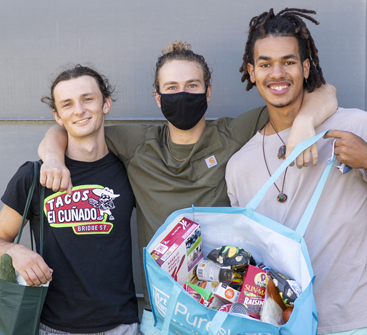As much as most of us don’t want to, let’s think back to the beginning of 2020… as the rapid spread of COVID-19 turned our world upside down, all levels of government needed more flexibility to address the impacts of the Public Health Emergency (PHE). In January of 2020, a PHE was declared for the entire United States by the federal Department of Health and Human Services.
What did the Public Health Emergency (PHE) do?

College students have higher rates of food insecurity but low rates of SNAP participation due to normal program requirements.
It allowed for flexibility in programs such as SNAP, the Supplemental Nutrition Assistance Program, to ensure more people who were in need could access help.
- Those enrolled in SNAP were provided with emergency allotments up to the maximum monthly benefit amount. Those already receiving the maximum benefit were allocated an additional $95 a month.
- Requirements that restricted eligibility for adults ages 18-49 without children were suspended allowing these individuals to receive SNAP for more than 3 months over three years.
- College students who, despite income eligibility, are often unable to qualify for SNAP had access if they were eligible for a work-study program (but not able to participate) or had an expected family contribution of zero.
Why is this important?
SNAP provides a greater return on investment than any other hunger-fighting initiative. It also benefits the economy as families spend benefits in local grocery stores. In addition to the economic benefits, SNAP helps ensure consistent nutrition as it provides access to healthier food options not possible with a small food budget.
But, the benefits are still inadequate. The Emergency Allotments allowed for $8.00 per person per day and will drop down to $5.40 after the PHE ends. College students have disproportionately higher rates of food insecurity but very low rates of SNAP participation due to normal program requirements. And the weekly variation in work hours, short-term contract work, and jobs without sick time mean adults without kids may need SNAP for more than 3 months to continue pursuing better employment opportunities.
When does the PHE end?
The PHE was recently extended again until October 2022. It is unclear if it will be continued at that time. SNAP and Medicaid flexibilities will end approximately 30 days after the declaration.
So, what can I do to help?
There are bills currently in Congress and an upcoming Farm Bill that open opportunities for making sure adequate SNAP benefits get to all those who need them.
The actions you can take right now:
- Spread the word through your networks about what will happen when the PHE ends and about the potential, we have to improve SNAP! Use your social media to make sure people know you have to be healthy to go to school or work. And you can’t be healthy without access to nutritious food.
- Keep an eye on our social media! We will let you know when it is time to activate and get in touch with your elected official.
